Mastering the Craft of Brewing Kvas: A Traditional Guide
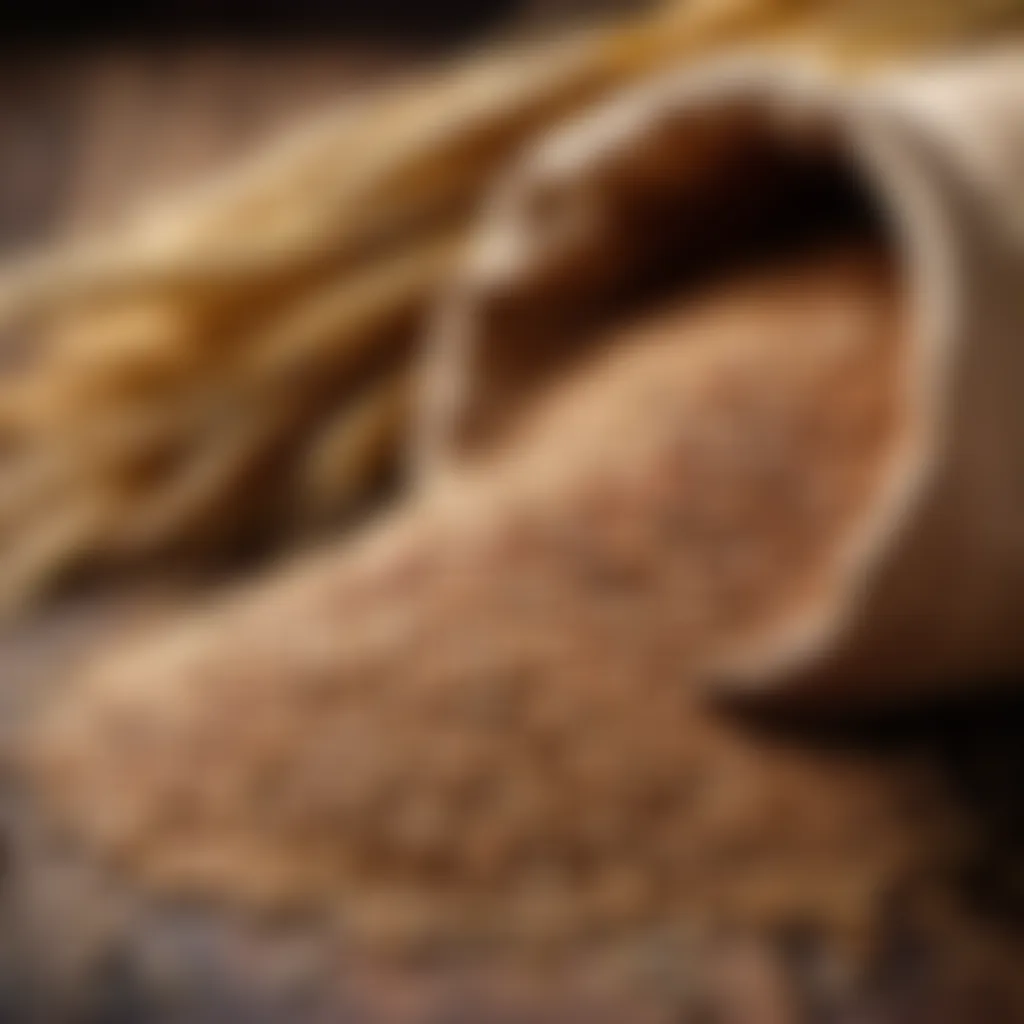
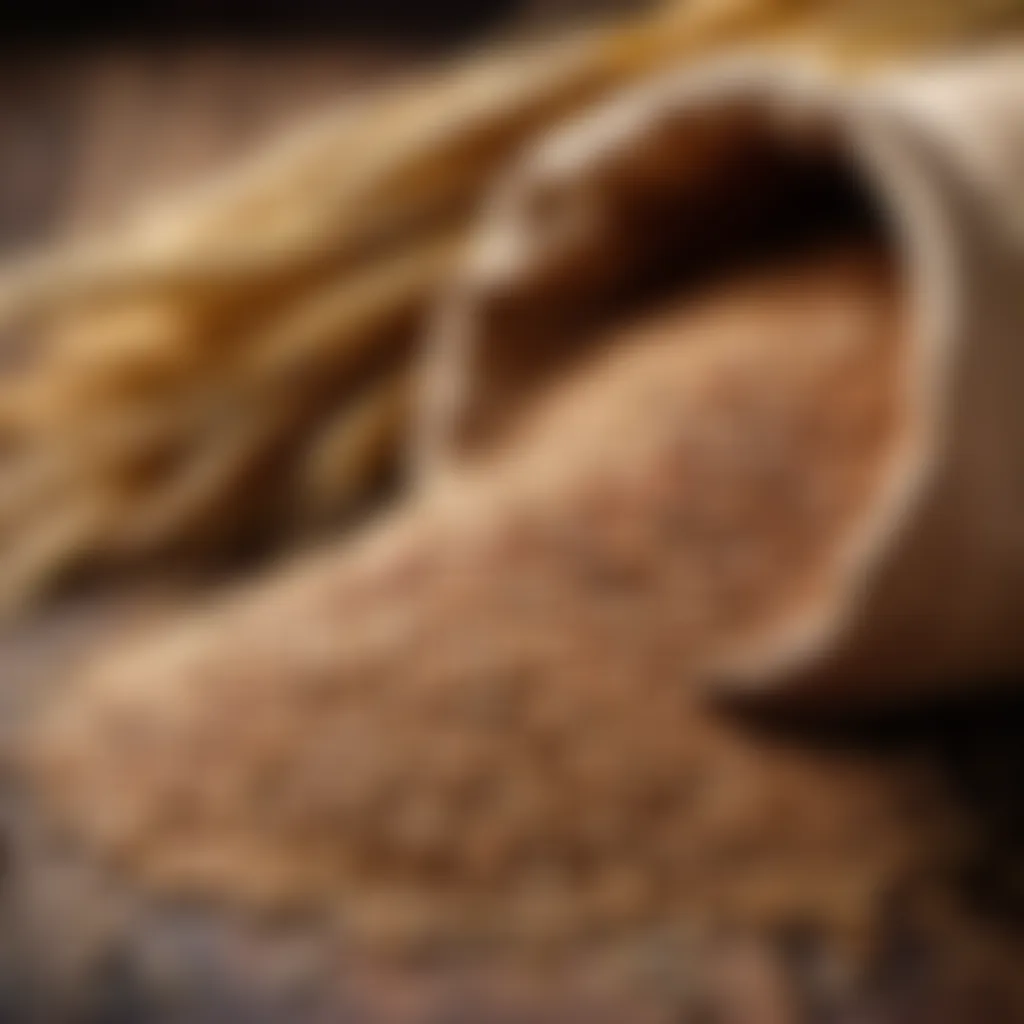
Intro
Kvas has long been a staple in the culinary landscape of Eastern Europe, evoking a sense of home and nostalgia for many. This fermented beverage is the kind of drink that connects generations, with its simple ingredients and ancient processes. While it’s often called a soft drink due to its low alcohol content, kvas embodies a complex world of flavors and textures that showcases the art of fermentation.
From its humble beginnings rooted in the fast-paced everyday life of peasants, kvas has become a cherished tradition that warms both body and spirit. Whether used as a refreshing thirst quencher on a hot summer day or enjoyed alongside a hearty meal, kvas holds a special place in the hearts of those who brew and consume it.
In this article, we’ll unfold the art of brewing kvas, guiding through each stage from gathering ingredients to savoring this effervescent drink. The process of making kvas is not just about mixing flour and water; it’s about creating a piece of history, a genuine connection to the land and its people. Let’s roll up our sleeves and dive into the delightful world of kvas, beginning with the essential ingredients.
Intro to Kvas
Kvas, a cherished beverage originating from the heart of Slavic traditions, represents more than just a drink; it symbolizes a rich tapestry of culture and history that has spanned centuries. Within this section, we will delve into the essentials of what kvas is and explore its historical backdrop, setting the stage for understanding how this fermented delight has found its way into modern kitchens.
Defining Kvas
At its core, kvas is a fermented beverage made primarily from rye bread, water, and a touch of sugar. This simple concoction undergoes fermentation, leading to its distinctive sour-sweet flavor profile. Unlike some alcoholic beverages, kvas is typically low in alcohol content, generally hovering around 1-2%. It offers a refreshing and slightly effervescent quality that awakens the palate.
Throughout Eastern Europe, particularly in Russia and Ukraine, kvas is often considered a staple. It’s not only served as a standalone drink but also paired harmoniously with various dishes. The beauty of kvas lies in its versatility; it can be enjoyed cold on a hot summer day or as a comforting presence during chilly months.
Historical Context
Kvas has a storied past, dating back to ancient times. It is believed that the earliest forms of kvas emerged as far back as 2000 years ago. The word itself, derived from the Old Slavic word “kvasiti,” means "to ferment." Traditionally, it thrived in peasant households across the vast terrains of Eastern Europe.
Life was not easy for the common folk; hence, kvas became a source of sustenance and hydration. It was inexpensive and made from simple ingredients, often regarded as a soft drink for the masses. The fermentation process was seen as a magical transformation, turning humble bread into something vibrant and life-giving.
As the years rolled on, kvas found its place in festivals and daily life alike. It was often brewed in large quantities, with families passing down recipes and techniques through generations, creating a rich culture around its brewing methods.
"Kvas is not just a drink; it is a bridge connecting us to our ancestry and traditions, resonating with every sip we take."
Kvas has also adapted through time, integrating with various cultures and communities, each adding their twist. In the modern era, it sees a revival, especially among home brewers eager to connect with this age-old tradition and recreate the flavors of their heritage. For housewives and culinary enthusiasts alike, mastering kvas brewing opens a door to both creative expression and a rich history steeped in community bonds.
In summary, kvas encapsulates both the simplicity of its ingredients and the complexity of its cultural significance, making it an intriguing subject as we journey deeper into the art of brewing this delightful beverage.
Ingredients for Brewing Kvas
Brewing kvas is an art, but like most forms of art, it begins with the right ingredients. This section focuses on the importance of selecting the appropriate components that not only influence the flavor and aroma of the drink but also ensure a successful fermentation process.
Understanding what goes into kvas gives future brewers a solid foundation to work from, allowing for creativity and experimentation while staying true to tradition. Let's take a closer look at what makes up a quality brew.
Essential Components
There are several key ingredients that come together to create kvas. Each plays a distinct role in the brewing process. At its core, kvas typically consists of the following components:
- Bread: Traditionally, stale rye or barley bread is the primary ingredient contributing to the drink's characteristic flavor. It's the sugars present in the bread that ferment and produce the tangy taste.
- Water: Purity matters here. Using clean, filtered water is vital, as it can affect both the fermentation and overall flavor profile.
- Yeast: A crucial player in the fermentation game, yeast converts sugars into carbon dioxide and alcohol. While you can choose to use store-bought yeast, many opt for the wild yeast that might already be present on the bread.
- Sugar: Depending on personal taste, additional sugar may be added, enhancing sweetness and alcohol content. It’s essential not to overdo it, as balance is key in brewing kvas.
- Spices and Flavorings: Optional, yet common additions include herbs like mint, or spices like coriander. These can enhance the drink's flavor complexity.
Each of these ingredients contributes to the final brew, thus influencing both its taste and fermentation process in significant ways.
Choosing Quality Ingredients
Selecting high-quality ingredients is half the battle in achieving a flavorful kvas. Fresh and local ingredients often yield the best results, reflecting the region's terroir.
- Bread: Opt for whole-grain or sourdough varieties. They bring complex flavors that enrich the drink. Avoid fresh bread, as it lacks the necessary staleness that promotes fermentation.
- Water: Always go for filtered or spring water, steering clear of any water laden with chlorine or heavy minerals. You want something refreshing yet neutral in taste.
- Yeast: If you wish to use store-bought yeast, select a quality brewing yeast specifically for fermented beverages. For a more authentic kvas, however, allow the wild yeast from the bread to handle the job.
- Sugar: Natural sugars from sources like honey or molasses can impart additional flavors. It's wise to start with a small amount to keep things balanced.
Taking the time to choose the right ingredients may require a bit of effort, but every step counts towards achieving that perfect batch.
Variations with Additives
While traditional kvas has a classic profile, there’s no shortage of room for personal flair. Additives can significantly transform the character of your drink. Here are some popular variations:
- Fruit Additions: Adding fruits like apples, berries, or raisins can infuse your kvas with delightful fruity notes, adding complexity and freshness.
- Herbs and Spices: Experimenting with spices such as ginger or vanilla offers an unexpected twist, making your homemade kvas stand apart from the ordinary.
- Flavored Syrups: Some mix in flavored syrups or even tea for unique infusions that can tailor the finished product to your personal palate.
When integrating additives, it’s wise to start with small amounts to discern how they affect the initial batch. Building upon your personal taste will lead you to a kvas that is uniquely yours, while still maintaining the essence of tradition.
Take the time to experiment with different combinations, because, at the end of the day, brewing kvas is as much about tradition as it is about personal expression.
By being attentive to both the essential ingredients and the quality of each, along with the possibilities for variation, brewers can craft kvas that is not just refreshing but also deeply satisfying.
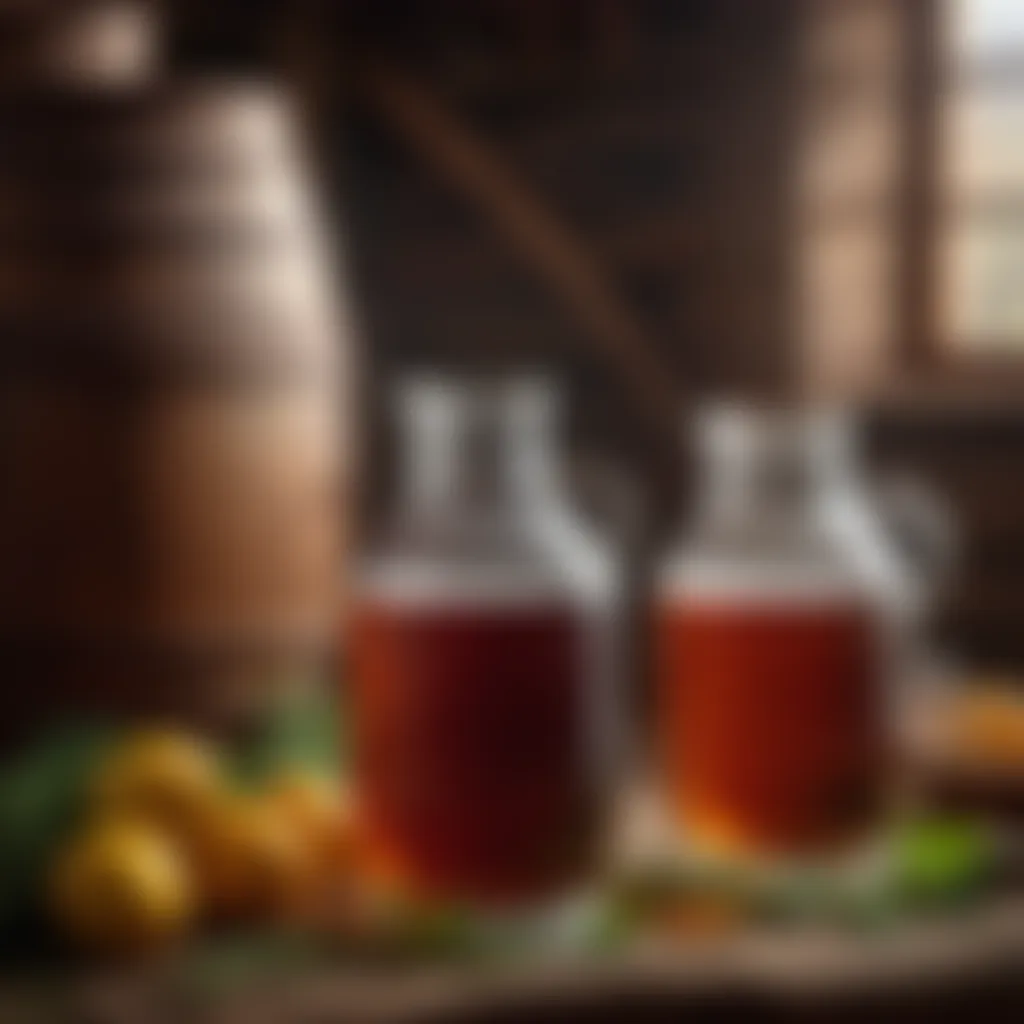
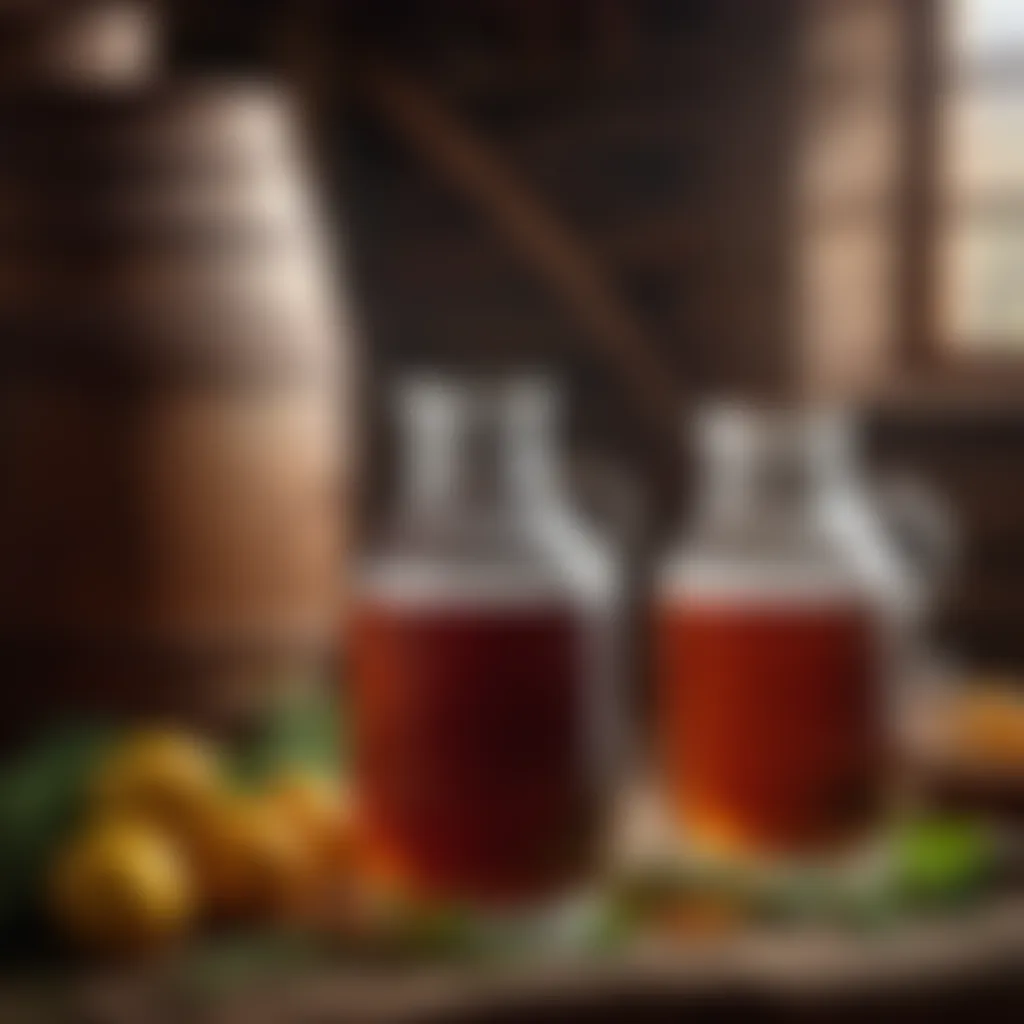
Cultural Significance of Kvas
Kvas transcends mere refreshment; it embodies a cultural ethos deeply rooted within Slavic heritage. This traditional fermented drink, often viewed through the lens of folklore and communal gatherings, acts as a connective thread binding generations. Throughout history, kvas not only served as a staple beverage but also as a symbol of hospitality and social communion. To fully grasp its significance, we should consider its role in daily life, festive occasions, and its representation of communal identity.
Kvas in Slavic Traditions
Historically, kvas has been a part of Slavic traditions since ancient times. It’s common to encounter scenes where families or communities gather to brew it together, sharing stories and laughter alongside the bubbling mixture. This communal brewing isn't just about drinking; it represents a ritualistic practice passed down through the ages. For instance, among the Russians, kvas has been a part of holiday celebrations. The drink is flavored and embellished for special occasions, making its consumption a celebrated event.
Additionally, food offerings such as blini (thin pancakes) or hearty rye bread are often paired with kvas, enhancing the culinary experience. The very act of drinking kvas is laden with tradition; its consumption is a nod to heritage, especially during major holidays or festivals where it flows freely amongst other festive foods. The drinking of kvas taps into the communal spirit—reminding drinkers of their roots and the importance of shared experiences.
Modern Perspectives on Kvas
In today's fast-paced world, kvas is experiencing a renaissance. As society becomes more interested in fermented foods and beverages, kvas is carving out a niche for itself both at home and in the marketplace. People are rediscovering this traditional drink, often due to growing awareness around the health benefits of fermented products.
Modern enthusiasts are experimenting with flavors and brewing techniques while still honoring age-old methods. Innovations abound, with variations including fruit-infused kvas or even spice blends that render unique flavors, making it appealing to new generations. There’s also a focus on local sourcing and organic ingredients, reflecting a broader food movement that values sustainability.
Not only is kvas prevalent in Eastern Europe, but its global appeal is also rising. You may find it in international food markets, where it’s no longer labeled just a regional drink but rather a 'fermented sensation'. This evolution of kvas from a local tradition to a global drink signifies its enduring appeal and adaptability.
"Kvas connects the past to the present, reminding us that some traditions are worth keeping alive for the next generation."
Understanding kvas cultural significance today means appreciating it as both a historical artifact and a contemporary delight. It tells the story of people, the passage of time, and unity amidst diversity.
To sum it up, the significance of kvas transcends simply being a drink; it’s a multifaceted cultural artifact. By weaving it into both ancient practices and modern interpretations, kvas continues to hold a place at the table—inviting everyone to share in its rich heritage while looking toward its future.
Understanding Fermentation
Fermentation isn't just a process; it’s the heartbeat of brewing kvas. This pivotal stage converts simple ingredients into a delightful, tangy beverage while also enhancing its flavor and nutritional profile. Understanding fermentation allows brewers to appreciate the delicate balance of elements that lead to successful kvas production. This section explores the essentials of fermentation—what it is, its significance, and the factors that can make or break the brewing experience.
The Science of Fermentation
Fermentation is, simply put, the transformation of sugars into alcohol and carbon dioxide through the action of yeast and bacteria. This process has been harnessed for centuries. In the case of kvas, it typically takes place in a controlled environment where the right conditions enable fermentation to flourish.
Some of the crucial aspects of fermentation include:
- Microbial Activity: Different strains of yeast and bacteria play diverse roles in fermentation, producing distinct flavors.
- Anaerobic Conditions: Since kvas is generally fermented in a closed container, it prevents the entry of oxygen, which can spoil the brew.
- Time Factor: A longer fermentation allows for more complex flavors, while shorter times might result in a sweeter beverage.
Understanding these elements helps in tailoring the fermentation process to suit personal taste.
Role of Yeast and Bacteria
At the center of the fermentation process are the unsung heroes: yeast and bacteria. While most people are familiar with yeast in baking, its role in brewing kvas is fascinating. Different types of yeast, like Saccharomyces cerevisiae, are responsible for converting sugars into alcohol, while wild bacteria contribute to the tangy taste by producing lactic acid.
- Yeast: While it stands as the primary agent of fermentation, each yeast strain offers unique flavors and aromas. Selected for their specific characteristics, the yeast used in kvas can alter its final taste dramatically.
- Bacteria: Often overlooked, these microorganisms can introduce sour notes that give kvas its signature zing.
In essence, the balance between yeast and bacteria determines the complexity and taste profile of the final product.
Impact of Temperature and Time
Temperature and time act as the two key variables in the fermentation equation. These factors can significantly influence how your kvas turns out.
- Temperature: Ideal fermentation temperatures typically range from 18 to 24 degrees Celsius (64-75°F), depending on the strains used. Higher temperatures can speed up fermentation but may also introduce off-flavors. Conversely, lower temperatures can result in slower fermentation, which may enhance flavor complexity.
- Time: Fermentation duration is equally important. A longer fermentation can yield a richer flavor but may also lead to excessive sourness. Most kvas brews will ferment between 1 to 3 days, allowing home brewers to experiment and fine-tune their recipes.
Ultimately, being mindful of these aspects enables brewers to create kvas that reflects their individual palate preferences.
"The art of brewing kvas is a delicate dance between flavor, temperature, and time."
By honing your understanding of fermentation, you’re well on your way to crafting a uniquely flavorful batch of kvas. Those who take the time to learn will find it immensely rewarding, enriching not only their kitchen repertoire but also their connection to this age-old beverage.
Traditional Brewing Techniques
When it comes to creating kvas, the methods employed in traditional brewing play a significant role. The techniques can determine not just the taste and quality of the finished product, but also the authenticity of the drink itself. With kvas being deeply rooted in cultural rituals and home practices across Slavic nations, there’s immense value in understanding these time-honored techniques. They bring a texture of history and connection to the drink that modern methods often lack.
Choosing traditional brewing methods encourages a hands-on approach, allowing brewers to engage with the ingredients and the fermentation process itself. It’s this connection that imbues kvas with warmth and character, marking it as more than just a beverage, but a story in every bottle.
Moreover, using traditional methods enables brewers to control elements such as flavor, aroma, and effervescence. Each choice made during brewing can alter the end result, creating a unique experience. The subtleties derived from these techniques are worth their weight in gold, bringing out the inherent flavors of rye bread, honey, or herbs that are often used in recipes.
Step-by-Step Brewing Process
Brewing kvas at home doesn’t have to be daunting. Following a clear, step-by-step process can demystify the craft. Here’s a simple guide to help you brew your own kvas:


- Gather Your Ingredients: You’ll need rye bread, sugar, and water. Feel free to get adventurous by adding fruits or herbs.
- Prepare the Bread: Cut the rye bread into cubes and toast until they are golden brown. This enhances the flavor.
- Mix the Ingredients: In a large pot, combine the toasted bread, sugar, and boiling water. Stir well and allow the mixture to cool.
- Add Yeast: Once cooled, sprinkle yeast over the mixture and stir it in gently. If you’re feeling ambitious, you can also add some of your previous kvas as a starter.
- Fermentation: Cover the pot with a clean cloth and place it in a warm area. Let it ferment for approximately 24-48 hours. The longer it ferments, the stronger the flavor.
- Strain and Bottle: After fermentation, strain out the solids and pour the liquid into clean bottles. Avoid filling them to the brim to allow for carbonation.
- Refrigerate: Place the bottles in the fridge. This slows down fermentation and gives you a nice chilled kvas ready for enjoyment!
"Brewing kvas is not just a process; it’s an act of love, passed down through generations. Each batch tells a story."
At-Home Brewing vs. Commercial Production
While commercial production of kvas can adhere to strict standards, home brewing offers a level of creativity that simply can’t be matched. When brewing at home, each batch can reflect personal taste preferences and regional influences. Home brewers have the flexibility to modify ingredients and methods, experimenting until they find a blend that truly resonates with them.
On the flip side, commercial production can ensure consistency in flavor and quality. They often utilize advanced equipment and processes that can achieve precise results. It can be a great way to discover a baseline flavor that can then inspire home brewers.
However, the soul of kvas lies in its roots. The omission of industrial methods means that when you brew at home, you’re maintaining traditions that have been alive for centuries. The act of brewing becomes not just a routine but a joy, a moment to cherish with friends and family.
In summary, whether you’re brewing kvas at home or purchasing it from a store, the essence of kvas remains vital. Choose the path that suits your palate, and enjoy the age-old tradition that this lovely drink embodies.
Kvas Recipes from Different Regions
Kvas is more than just a refreshing beverage; it embodies the cultural heritage and culinary traditions of the Slavic peoples. Each region adds its own unique twist, making kvas a diverse drink with a tapestry of flavors influenced by local ingredients and traditions. By exploring the recipes from different regions, we uncover the essence of kvas and its ability to unite communities through a shared love of this fermented delight.
Russian Kvas Variations
Russian kvas is perhaps the most recognized version, often regarded as the classic. One of the standout recipes is the traditional rye kvas, which uses dark rye bread as its base. The bread is toasted until golden brown, contributing a deep flavor and color. The brewing process typically involves:
- Disolving the toasted bread in water along with sugar and yeast.
- Letting the mixture ferment for about 2-3 days at room temperature to develop a slight fizz.
- Straining the liquid through cheesecloth to remove the solids before bottling.
Moreover, some regions enhance their kvas with various flavorings such as raisins, mint, or horseradish. Each addition brings a different character, providing a glimpse into the area's palate and preferences.
Ukrainian Kvas Recipes
Ukrainian approaches to kvas often highlight its versatility with wild and diverse ingredients. Notably, Ukrainian beet kvas is a vibrant option that blends earthy beetroot with the traditional recipe. The preparation usually includes:
- Boiling diced beets and allowing them to cool before adding them to the fermented base.
- Incorporating additional herbs like dill to create a refreshing, slightly tangy drink.
This variation is particularly cherished during warmer months, served chilled with a pinch of salt for balance. Ukrainians have also been known to add other ingredients such as apples or caraway seeds, showing just how adaptable kvas can be.
Belarusian Approaches to Kvas
Belarusian methods highlight a shorter fermentation process that yields a mildly sweet beverage, often enjoyed by children and adults alike. A key recipe involves using birch sap, which adds a subtle sweetness and a hint of the forest to the drink. The steps typically include:
- Combining birch sap with water and a small amount of rye bread to initiate fermentation.
- Allowing the mixture to rest for only a day or two, resulting in a gentler flavor profile.
Their kvas recipe often incorporates seasonal fruits like cherries or berries, giving it a unique twist that varies throughout the year. The use of local resources not only enhances flavor, but also promotes sustainability and a connection to the land.
"In each region, kvas is not just a drink; it's a part of the identity, telling stories of history and tradition."
As we see, these regional variations of kvas not only differ in ingredients, but also in methods of preparation and culture. This rich variety adds to the allure of brewing kvas, inviting housewives and food enthusiasts alike to explore the flavors that best represent their own heritage or curiosity. Whether one leans towards the robust Russian recipe or prefers the sweet notes of Belarusian kvas, each sip connects to a broader narrative, making brewing kvas an engaging journey worth undertaking.
Troubleshooting Kvas Brewing
Brewing kvas, while steeped in tradition, is not without its share of challenges. Understanding the potential pitfalls of this process can mean the difference between a vibrant, effervescent brew and a flat, lifeless concoction. Troubleshooting during kvas brewing is crucial, especially for home brewers looking to replicate the enchanting flavors that this beverage is known for. When you encounter issues, it’s an opportunity to learn, adjust, and ultimately improve your kvas game. This section aims to illuminate some common hurdles and provide thoughtful solutions to ensure your brew becomes a success story.
Common Issues Encountered
Several factors can lead to problems in the kvas brewing process. A few prevalent concerns include:
- Inconsistent Fermentation: This can happen if the fermentation temperature fluctuates. Yeast prefers a stable environment to thrive.
- Off-flavors: Sometimes kvas can have an unexpected sourness or bitterness, often due to over-fermentation or poor-quality ingredients.
- Over-carbonation or Flatness: You might find your kvas too fizzy or surprisingly flat. This is frequently linked to the balance of sugars and yeast activity.
- Clarity Issues: If your kvas appears murky, it could be due to incomplete fermentation or not filtering properly before bottling.
Understanding these common issues can empower you as a brewer. Just because something goes awry, it doesn’t mean it’s the end of the line for your attempts.
Solutions and Best Practices
Addressing these brewing challenges requires a blend of knowledge and execution. Here are some practical solutions:
- Temperature Control: Invest in a thermometer to monitor the brewing environment closely. Maintaining a consistent temperature between 18-24°C (64-75°F) will help ensure that fermentation progresses smoothly.
- Quality Ingredients: Always source fresh, high-quality grains and yeast. This not only impacts flavor but can prevent some off-flavors that occur due to old or subpar ingredients.
- Taste Regularly: Sampling your kvas in the brewing process helps detect off-flavors early. If the taste seems too sour, you can transfer it to a cooler place to slow fermentation.
- Adjusting Sugar Content: If your kvas is too fizzy, reduce the added sugar in future batches or shorten the fermentation time. To fix flat kvas, consider a secondary fermentation with controlled sugars to bring back that sparkle.
- Filtering Techniques: Use fine mesh or cloth to filter your kvas before bottling. A bit of patience here goes a long way in presenting a clearer final product.
Remember: Troubleshooting is not about performance but about adaptation and growth. Every challenge is a stepping stone to mastering the delicate art of brewing kvas. Every home brewer has had their share of mishaps, and with these best practices, you're well on your way to crafting a delightful brew.
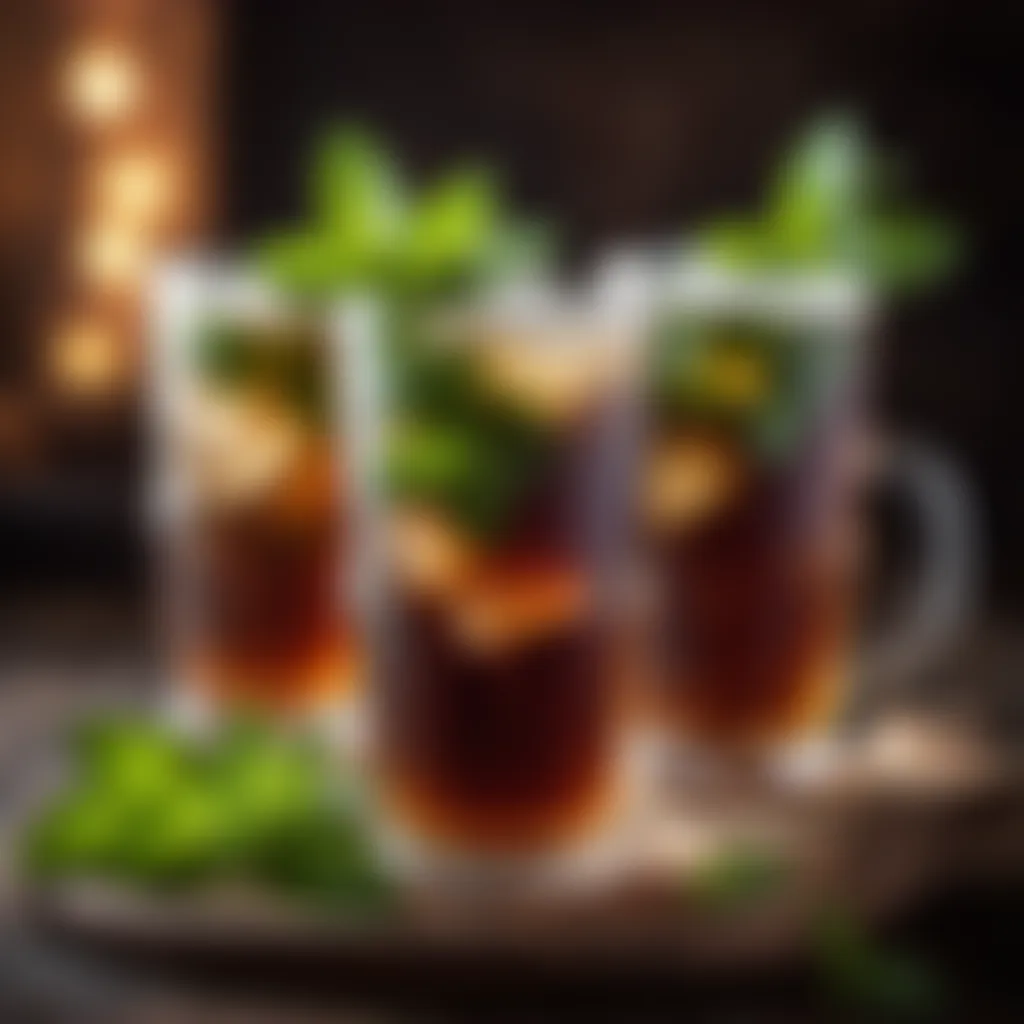
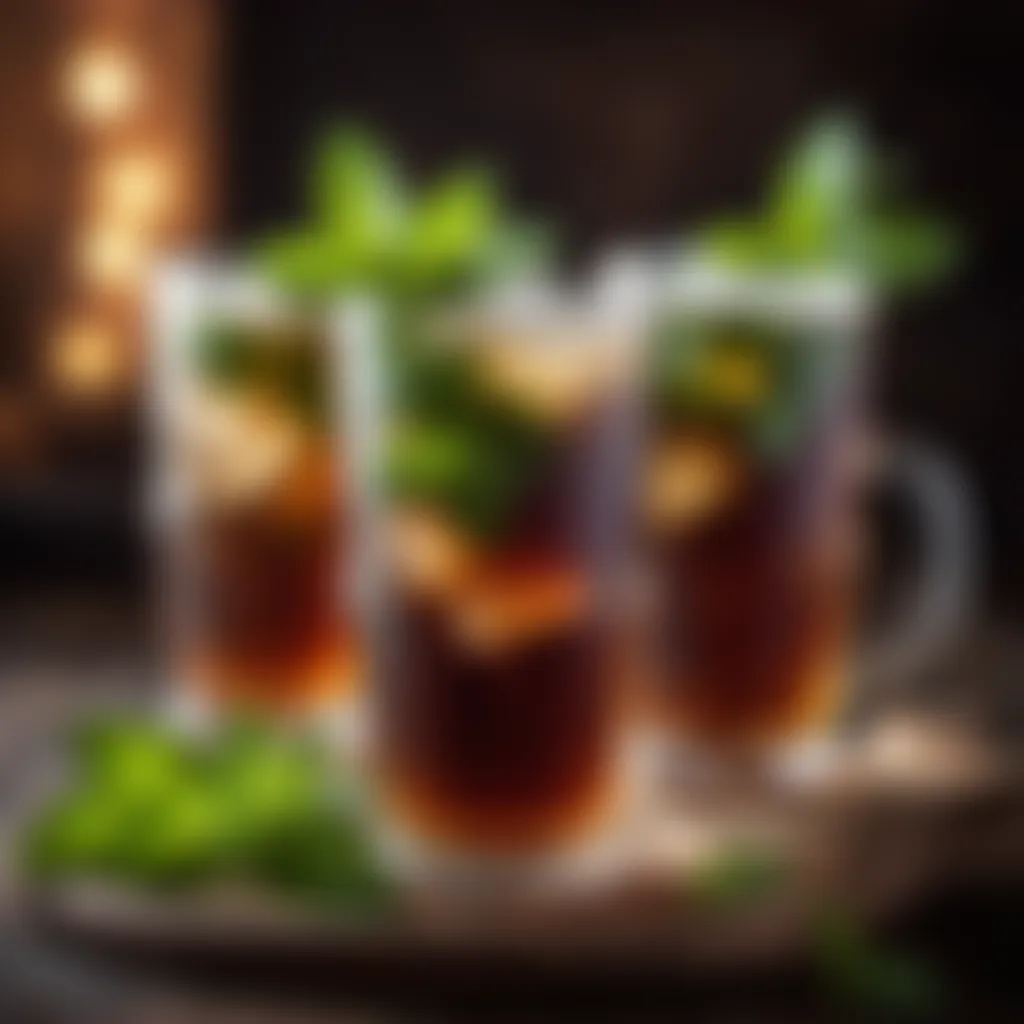
Serving and Enjoying Kvas
The way we serve and enjoy kvas affects not just the taste but the entire experience surrounding the drink. Kvas is more than a beverage; it's a connection to a rich cultural heritage. Knowing how to serve it can enhance the social interactions it often accompanies. Getting the temperature right and selecting the right glasses can elevate what might merely be a drink into a delightful ritual, keeping both tradition and flavor at the forefront.
Ideal Pairings with Food
Pairing kvas with the right dishes can seem daunting, but the truth is, a few general principles will make this process much more enjoyable. Kvas, with its slightly sweet yet earthy flavor, offers a versatile palate that can complement a wide array of foods. Here are some food pairings that many have found delightful:
- Borscht: This vibrant beetroot soup is a staple in Slavic cuisine and finds a perfect companion in kvas. The acidity in both can create a balance that is hard to beat.
- Dumplings: Whether they are filled with meat or vegetables, dumplings work charmingly with the refreshing qualities of kvas. It's like a dance of flavors that can leave your tastebuds singing.
- Herring and Rye Bread: Traditional herring dishes, especially when served with dark bread, match beautifully with kvas, adding layers of taste that bring a sense of satisfaction.
- Pickled Vegetables: The crunch of pickles can contrast well with kvas’s lighter notes, bringing out a nice balance without overpowering the drink.
As the old saying goes, "Good food deserves good drink." This rings especially true with kvas, as the right pairing can uplift an everyday meal into something special.
Kvas in Social Settings
Kvas holds a special place in social settings, particularly in Slavic cultures. Think of it as a bridge that connects friends and family together. It's not just about quenching thirst; it’s about sharing stories and laughter over a glass of kvas. Imagine a summer BBQ where kvas flows freely amongst plates of grilled sausages, laughter filling the air. It's this effortless blend of tradition and enjoyment that makes kvas shine.
A common practice is to serve kvas in tall glasses, where its bubbly nature can be fully appreciated. Often, you might find the drink being passed around as a toast to celebrate special occasions. The atmosphere is thick with nostalgia and warmth. People often reminisce while enjoying kvas, as it holds stories not only of the past but also of the present.
In some cultures, kvas even finds a place at celebrations and rituals, showing that it is more than just a drink—it is a part of life itself.
"Kvas is to the Slavic people what wine is to the French; both are woven into the fabric of society and shared moments."
Embracing kvas in social settings not only nurtures connections but also keeps cultural traditions alive. Whether it's spent quietly with loved ones or amidst a lively gathering, enjoying kvas can create moments that last a lifetime.
The Future of Kvas
As we stand at a crossroads in the culinary landscape, the future of kvas beckons with a blend of tradition and innovation. This remarkably versatile drink not only represents a vital part of Slavic culture but also holds potential for reinvention and broader appeal in modern times. Embracing the future of kvas involves revisiting traditional methods, appreciating its ancestral roots, and recognizing its role in an increasingly health-conscious world.
One key element is the rising trend in health and wellness. Kvas is naturally fermented, offering probiotics that can benefit gut health. As consumers become more discerning and conscious of what they consume, drinks that provide health benefits without added sugars or artificial ingredients are gaining traction. This provides a ripe opportunity to market kvas in a way that highlights not just its cultural significance but also its health advantages.
Moreover, there are considerations about sustainability practices in brewing. As awareness of environmental issues rises, breweries and homebrewers alike are experimenting with sustainable approaches. These include sourcing local ingredients and reducing waste during production. Such practices can capture the attention of eco-conscious consumers and potentially expand kvas' reach.
Revival of Traditional Methods
Reviving traditional brewing methods is arguably one of the cornerstones of kvas' future. In a world driven by fast-paced consumption, there’s an increasing desire for authenticity and the stories behind our food and drinks. Homebrewers and craft artisans are eager to resurrect age-old techniques that have been passed down through generations.
Utilizing simple ingredients like bread, water, and natural sweeteners—while steering clear of commercial yeasts—can create a more authentic kvas experience. This journey back to basics can evoke a sense of nostalgia, where every sip carries whispers of history.
"Kvas isn’t just a drink; it’s a connection to our roots—one that stirs memories of summers spent in grandmothers’ kitchens."
As communities gather to share and celebrate this beverage, the revival of traditional methods fosters a sense of belonging, offering a unique way to build connections among people of all ages.
Kvas in Global Markets
With the global market evolving, there's potential for kvas to carve out a niche. The fusion of diverse culinary traditions can lead to exciting innovations, blending kvas with flavors from other cultures. For instance, imagine a kvas cocktail that marries Eastern European roots with tropical fruits or spices from various cuisines. Such endeavors could introduce kvas to a wider audience, making it desirable for cocktail enthusiasts and foodies alike.
International food fairs and festivals provide platforms to showcase kvas on a global scale. Social media campaigns can further educate and entice consumers, making kvas not just a beverage but a conversation starter. Rising Instagram stars and influencers can showcase unique kvas recipes, helping to create buzz and organically spread awareness.
Ultimately, as more people step beyond their culinary comfort zones, kvas can emerge as a refreshing alternative to mainstream beverages. Capturing interest through creative marketing strategies and authentic experiences could well pave the way for kvas’ acceptance and enjoyment across borders.
By blending the ancient and the modern, kvas can secure its place not just within Slavic traditions but also as a vibrant part of the global beverage scene.
The End
Brewing kvas is not just an endeavor to create a refreshing beverage; it's a rich tapestry of tradition, culture, and art. Understanding this craft paves the way for deeper appreciation of the drink and its significance in various cultures. Reflecting on the brewing process provides clarity on each step, highlighting the nuances involved. From selecting the right ingredients to monitoring fermentation, every detail contributes to the flavor profile and character of your kvas.
Reflections on the Brewing Process
The brewing journey offers a chance to connect with one's heritage and share in a communal experience. When you dive into the steps, whether it's measuring the ingredients or waiting patiently for fermentation, you witness the magic unfold. It’s easy to overlook the transformation that occurs when starches ferment into sugars and, eventually, into that effervescent, tangy drink. This transformation takes time, and it requires attention. The patience required in this process allows the flavors to meld beautifully, creating something truly special.
Moreover, kvas is quite forgiving for those who are just dipping their toes into brewing. If the first batch isn't perfect, it doesn't mean it's a failure; rather, it's a learning opportunity. Reflecting on your experience encourages growth in your skills and understanding.
Encouragement for Homebrewers
For those considering taking the plunge into homebrewing kvas, I say go for it! There’s something profoundly satisfying about crafting something with your own hands. Kvas can be an accessible entry point into the world of fermentation. The ingredients are typically easy to find, and most equipment needed is fairly simple.
Don't feel daunted by the process! Start small and experiment with flavors or types of bread used. Lemons, herbs, or berries can add an interesting twist that transforms the final product. Engage your family or friends in the brewing process, making it a fun activity.
Remember to take notes of each batch. Jot down what works and what doesn’t. This creates a roadmap to refining your methods and discovering unique recipes that reflect your personal taste.
Embrace the adventure of homebrewing kvas. There will be blunders and successes in equal measure, but it’s all part of cultivating a delightful craft.
In the end, the act of brewing is all about connection— to the past, the ingredients, and to others who share your love for this age-old beverage. So roll up your sleeves, unleash your creativity, and enjoy the fascinating world of kvas.







